The story of Airplane Creek, BC
This post is about a mystery that’s been in my files for 35 years, that I have finally solved.
There are two creeks in British Columbia named Airplane Creek. One is a tributary of the upper Stikine River, but this post is about the one east of Chilliwack. It flows into Foley Creek at 49° 07′ 23″ N., 121° 36′ 11″ W., and Foley Creek flows into the Chilliwack River.
I’ll start with a couple of maps. Airplane Creek runs diagonally across this Google Map – click here to open an interactive version.
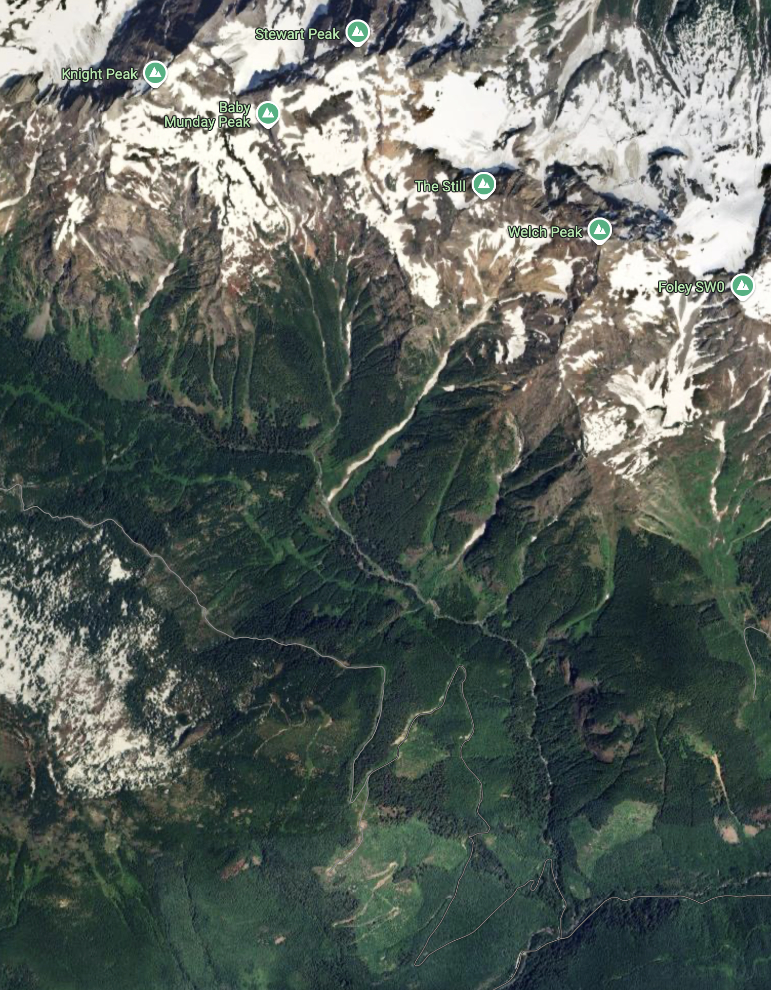
Mapcarta offers an excellent topographical map of the area, to give a better look at the drainages – click here to open an interactive version.
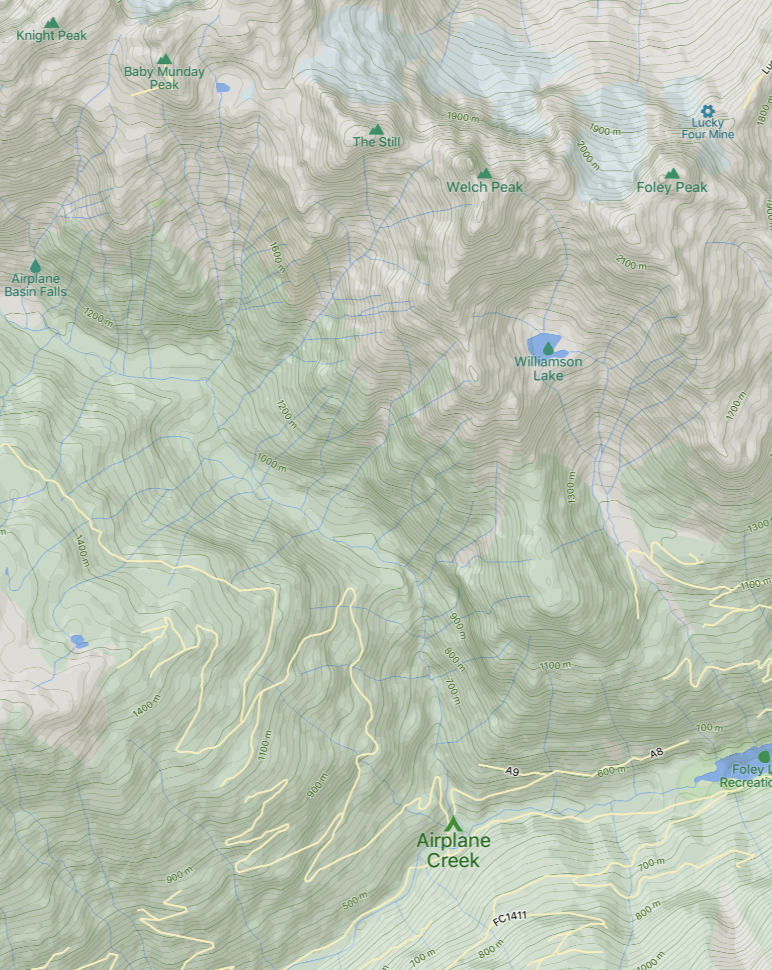
Now to the story. In November 1989, extremely heavy rains did massive damage in the Chilliwack River Valley. While assessing whether the damage was too great to continue writing a book about the hiking trails in the valley (it was far too great – I would have had to pretty much start over), I found several pieces of obviously very old aircraft wreckage on Airplane Creek. The next two photos were shot on November 22, 1989.
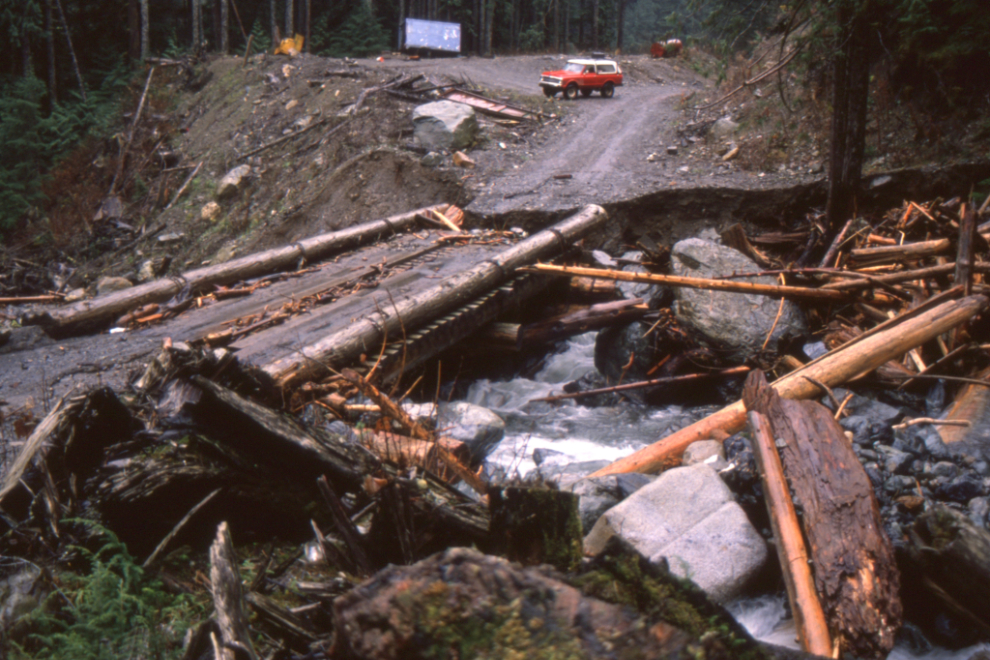
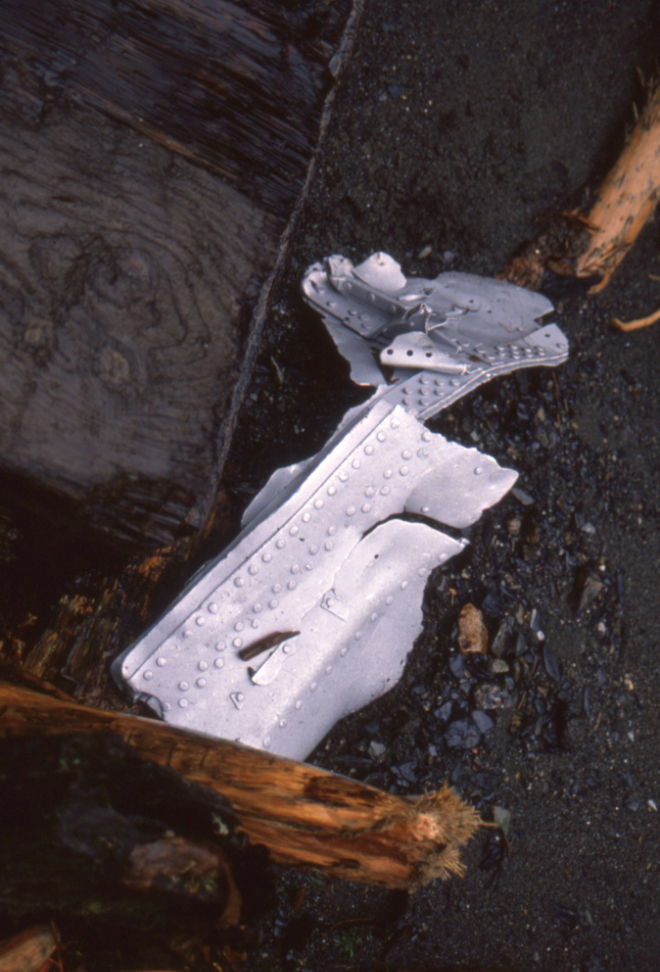
Research is much easier today than it was in 1989, and I now know that the wreckage was from one of two aircraft. The first is the one the creek was named for – Canadian Pacific Air Lines Lockheed 14-H2 Super Electra CF-CPD (msn 1504) crashed on Mount William Knight on December 20, 1942, killing 13 persons (3 crew and 10 passengers) instantly. Airplane Creek was named by a team sent in to that wreckage in August 1943 – that is confirmed by an article in The Chilliwack Progress of August 25, 1943.
The day after the aircraft disappeared, much of the front page of The Vancouver Sun was devoted to reporting on the by-now-certain crash. However, the area initially being searched, as shown on the map, was well north of where the plane was found late the next summer.
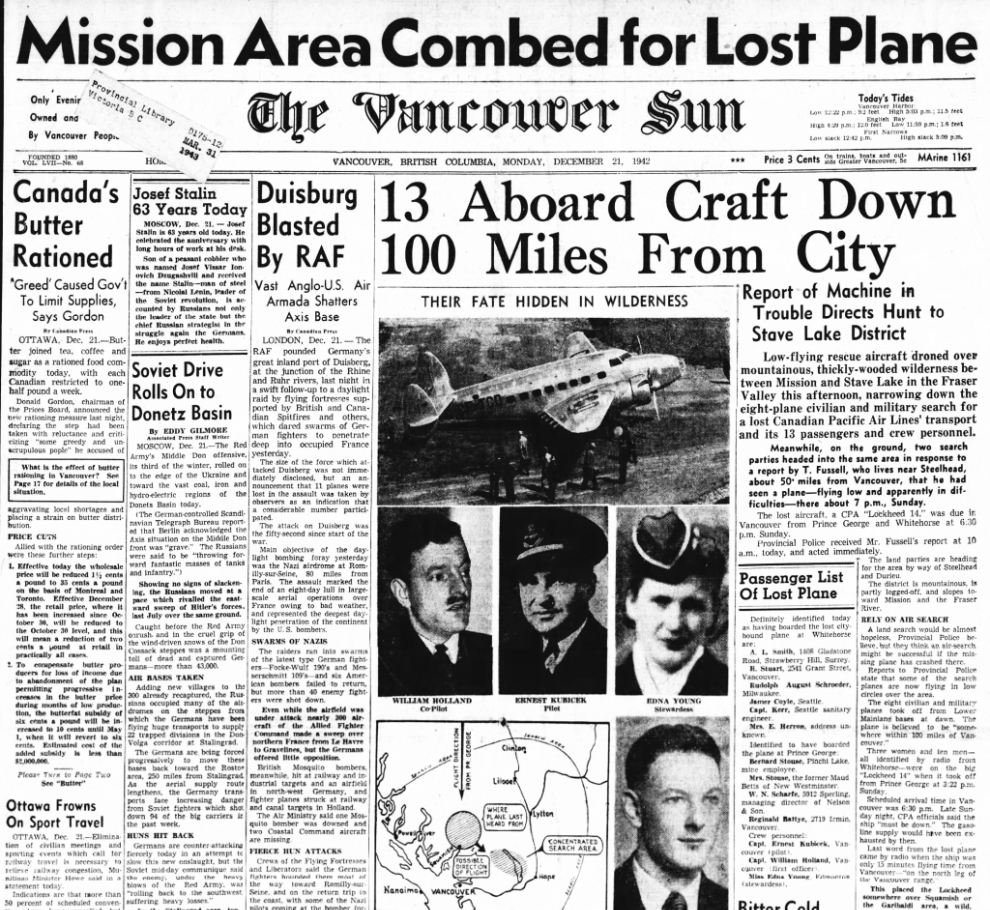
Although most newspaper reports reported that the flight had originated at Prince George, it had actually come from Whitehorse, with a stop at Prince George. Both the pilot, Ernest “Ernie” Kubicek, and the co-pilot, William “Bill” Holland, had flown in the Yukon, Kubicek for 2 years with the British Yukon Navigation Company (BYN), Northern Airways and Yukon Southern Air Transport, and Holland with BYN and Northern Airways.
No clues were found during 500 hours of aerial searches and extensive ground searches, both hampered by bad weather, and in early January 1943 the search ended. With snow at high elevations melting, the search was resumed on about June 20th, 1943, and the wreckage was found by a search plane on August 9th. On August 16th the first ground party reached the wreck and found pieces of the aircraft and its occupants spread over a wide area on both sides of a ridge at 7,000 feet elevation.
A coroner’s jury in September found that the crash was “an accident, the causes of which are unknown.” The passengers’ remains were buried at the crash site in early October.
We have reproduced many newspaper articles published from the time of the crash until the burials – you can read them here.
The other, more likely, source of the wreckage I found is RCAF Liberator bomber KK241, which, flying out of Abbotsford on a training mission, crashed on June 1, 1945, killing the 11 airmen aboard. Although reports said that it crashed into 6,600-foot Foley Peak, seen towards the upper right of both of the maps above, the crash site is actually 1.3 km to the west-northwest, between Welch Peak and The Still. From that crash site to Airplane Creek is a straight, steep gulley, making this the likely source of the wreckage.
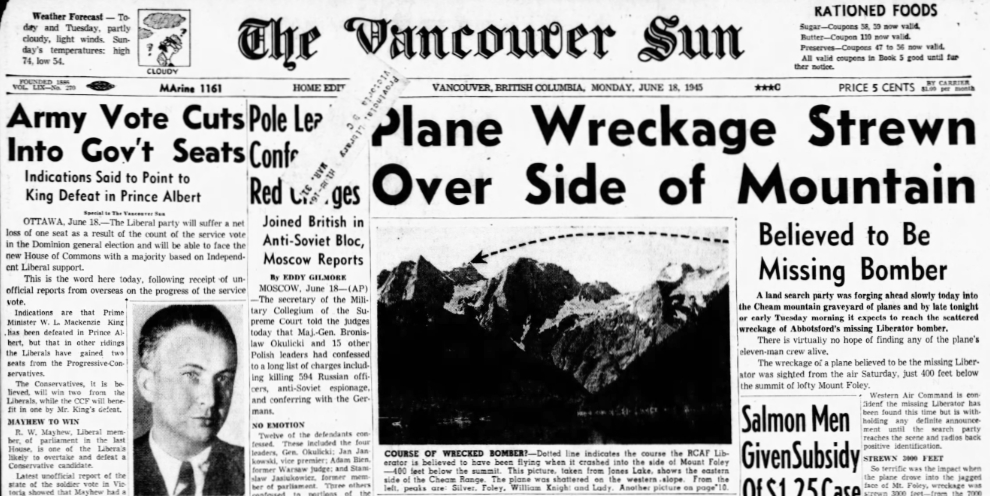
Two memorials to this crash have been built. In June 1983, Air Cadets from 861 Silverfox Squadron in Abbotsford, with Commanding Officer Chris Weicht, constructed a memorial cairn on top of one of the Liberator’s engines on an island in Airplane Creek. It was probably badly damaged in the disastrous floods of 1988 and 1989, and in 2015 a new memorial was built in Thompson Regional Park in the Chilliwack River Valley. Unfortunately many newspaper articles about these memorials have stated that Airplane Creek was named in honour of this crash, but as you can see above, that is not true.
As with the Canadian Pacific crash, we have reproduced many of the newspaper articles – you can read them here.
I’ll close this post with a photo of the final salute at the grave of the Lancaster crew.
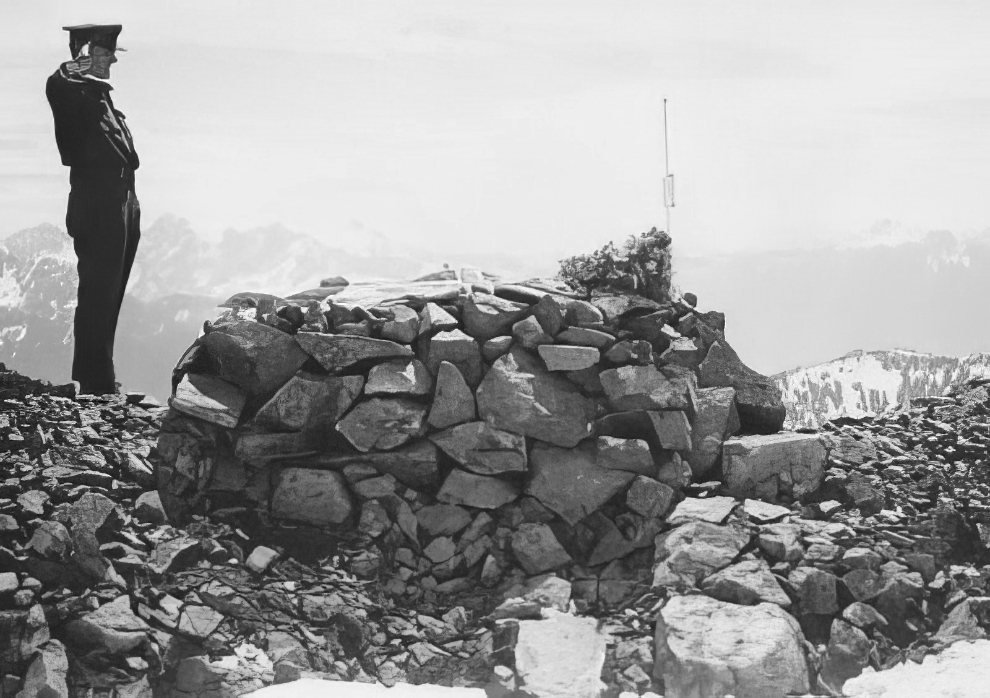

Hello! Greetings from Brazil! While searching for photos and stories about Skagway, the Chilkoot Trail, etc (I’m reading a book about the Alaska Gold Rush and I like to immerse myself more in the history), I came across your blog and was amazed by your photos (the first post I saw was “A day trip to windy and very wet Skagway, Alaska”, posted on October 5, 2022, but I couldn’t leave a comment there, so here I am on this most recent one)! I felt like I was strolling through those beautiful landscapes! I haven’t had the chance to go through all your posts in detail yet, but I saw that there are several about Alaska, and I just wanted to express in advance how much I appreciate your writings and records of this enchanted place (which I still plan to visit)! Please, keep posting! I will be delighted to follow your impressions!
Welcome, Natália – it’s always nice to have new readers introduce themselves. I had to disable commenting on old posts years ago because they attract a very large amount of spam posts. There are many hundreds of posts about Alaska here, from hikes, cruises, and road trips – I hope that you enjoy your virtual exploring here.
Unsolvable not with Murrster on the case, Mounties get their man but Murray solves the coldest of cases, great job on closing the case, what’s next on the docket 👍🎅🍺
I put a lot of hours into that one, but I’m back to James Henry Eastman (who died in Whitehorse in 1946) now – what part did he actually play in what became known as the Eastman Flying Boat? 🙂